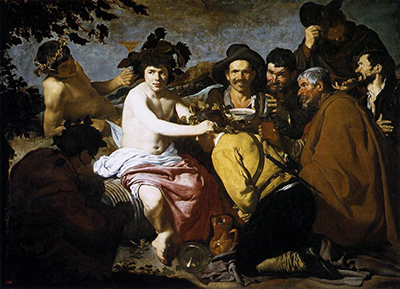Triumph of Bacchus
Diego Velazquez was born in Seville in 1599 and became one of the most iconic painters of his time with many of his works still adored today.

Velazquez was a prolific painter from a young age and his talent did not go unnoticed. Initially studying under Francisco di Herrera, he was subsequently apprenticed to Francisco Pacheco at the age of twelve. Pacheco was a renowned painter and teacher whose clientele most notably included royalty.
Velazquez flourished under Pacheco’s guidance and soon surpassed his master’s success, gaining attention from a wide audience. His early works consisted largely of religious scenes as well as depictions of every day scenarios, always with realism and strong influences of artistic styles emerging during that period. His apprenticeship ended in 1617 and a year later, Velazquez married Juana, the daughter of Pacheco.
In 1623, when Velazquez was twenty-four years old, he was asked to paint a portrait of King Philip IV. The king was so pleased with the painting that he decided no other artist would paint his portraits from then on, and Velazquez became a prominent figure at the king’s court. He continued to paint profusely and in 1628, produced The Triumph of Bacchus.
This stunning piece clearly demonstrates his great skill at capturing the realistic figures in what is otherwise a fantastical depiction acknowledged as his first attempt at painting a mythological scene.
Like so many of his works, the chiaroscuro technique is clearly apparent with the spotlight effect on the central figure of Bacchus being effectively balanced by the heavy dark shadows around the edges of the painting. Perhaps the most famous portrayer of this method was Caravaggio (1571-1610), whose paintings are noted for their striking use of dark and light which simultaneously draws the viewer into the painting while the subject matter almost seems to jump out from the canvas.
There is certainly a remarkable comparison between the works of Velazquez and Caravaggio and particularly in their images of Bacchus. Whilst Caravaggio’s Bacchus, painted in 1595, shows him in a rather less raucous setting as he reclines almost contemplatively in solitude, there is no doubt of the similarity between these portrayals of the god of wine compared to other depictions of Bacchus.
In The Triumph of Bacchus, Velazquez shows Bacchus surrounded by drunken men in good humour and indeed, the painting is commonly known as Los Borrachos, or The Drunks. Two of the main characters stare straight out of the painting at the viewer as if inviting them in to join the celebration; again this directness is often found in Caravaggio’s works to startling effect.
In the scene portrayed by Velazquez, a man is being crowned with vine leaves by Bacchus and there are various suggestions as to what this represents. Two of the other attendees also wear leaves in their hair like their host and it could be that this is simply part of the festivity, or possibly have a more symbolic meaning. Comparisons have been made with religious themes where Christ is blessing or healing someone kneeling before him, while other explanations refer to the fact that King Philip IV commissioned this piece and it represents the subjects bowing before the Crown.
Unquestionably, Velazquez demonstrates his remarkable aptitude for grounding a mythical scene in reality; the people enjoying his company could be ordinary townspeople and the revelry something which anyone walking through that forest could have chanced upon – possibly even joined in with!
The fact that Bacchus, the Roman god of wine and agriculture, is surrounded by ordinary-looking folk, does not seem incongruous; Velazquez applies a sensitivity and understanding to his portraiture which treats his subjects with a respect which gives them all a valid sense of place within the painting. The Triumph of Bacchus is painted in oil on canvas and measures 1.65m x 2.25m. It is on display in the Museo del Prado in Madrid.